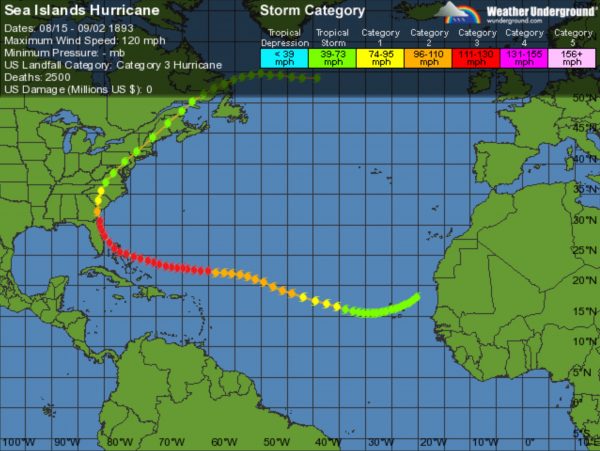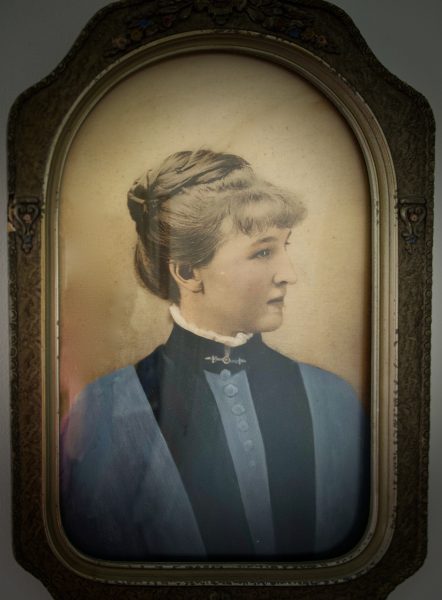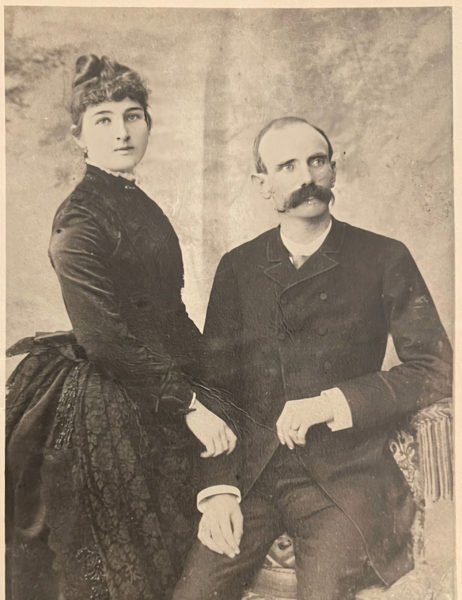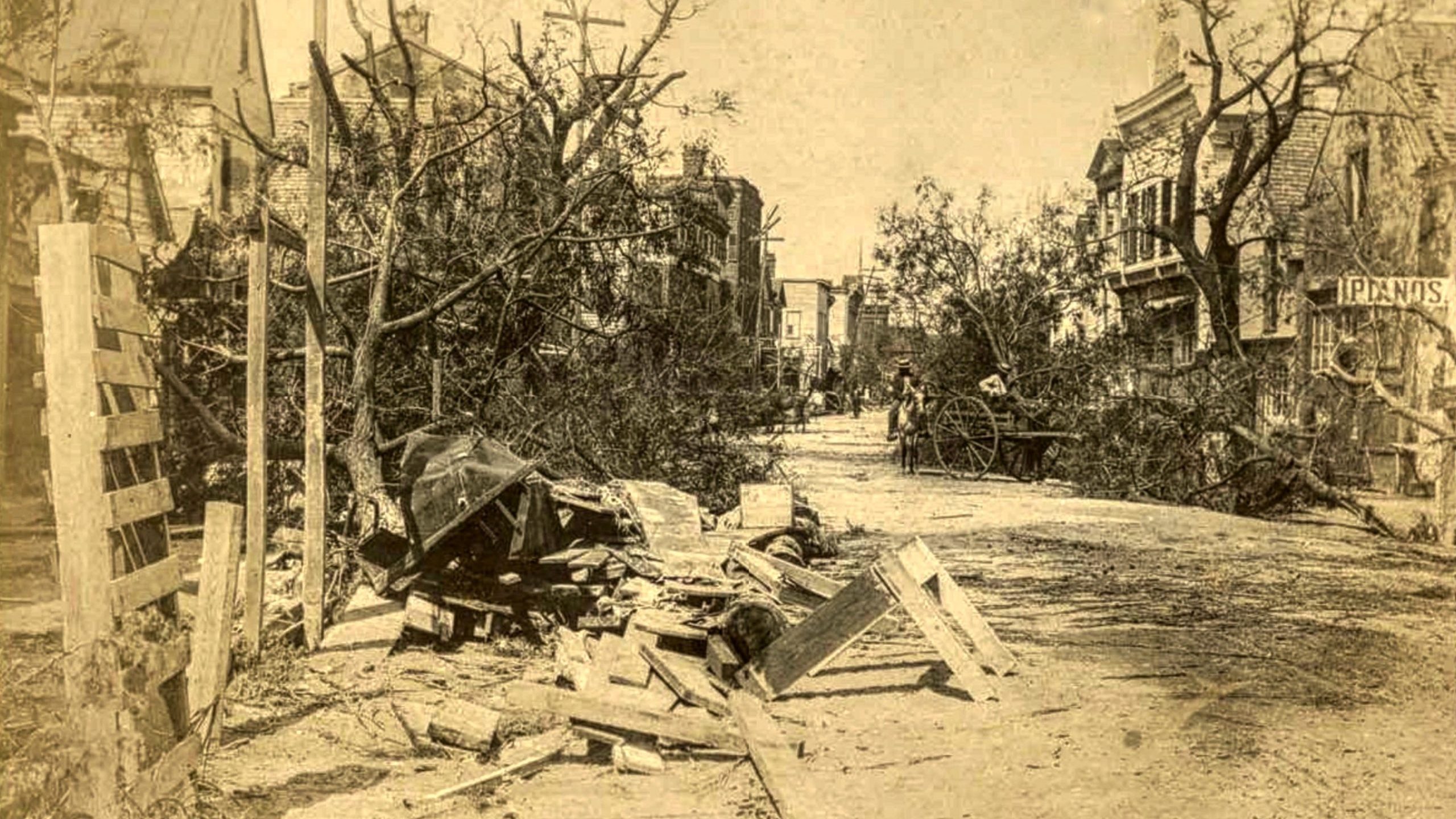[Updated September 5, 2022]
Water in motion is beautiful
—most of the time. But once in a while, it grows from a rising tide into a boiling hurricane. Water defines much of the character of our Lowcountry. It flushes and nurtures the marsh, defines the borders of our island, and pushes us away when a hurricane approaches.
Most of you know about the beauty of the waters around Dataw. It’s a contributing reason I live here. Fortunately, the “beast face” of water is seen less often. This week I’m going to tell you about the most massive hurricane this area has ever experienced—the storm of 1893. I’ll also tell you a little know story of Ting (Sams) Colquhoun’s ancestors that met their death in that hurricane.
The photo above shows Bay Street in Beaufort soon after the storm. The photo was taken near the intersection of Bay and Carteret, looking west towards the Verdier House. You can see a slice of it on the right, past the man on the horse.
Drowning was probably common
Waterways around the Sea Islands were, of course, essential routes for commerce and communication. But weather and accidents can happen. For example, I previously told you about James Edings Lawrence Fripp (1816 – 1864) and his wife Evelina Edings Sams (1822 – 1861). J.E. Lawrence Fripp was a contemporary of Thomas B. Chaplin, made famous by Theodore Rosengarten in his book Tombee: Portrait of a Cotton Planter.
In Chaplin’s diary entry for Jan 27th, 1852, he says,
“Heard that on Monday night, 19th ins., J.E. Lawrence Fripp, on his way from Beaufort in his boat, got capsized, he & four Negroes, who were all very fortunately saved by Mr. Caper’s Negroes, who heard their cries for help & went to them, they being near Mr. Caper’s plantation. 2 of the Negroes had swam ashore, but the other two & Lawrence were with the boat (which was bottom up) & very near exhausted when picked up.”
At the time, Lawrence was 36 years old. After his wife died and the war began, he fled to Barnwell Court House and died there in 1864. He and his wife, Evelina Sams, are buried in the Sams Family Cemetery on Dataw Island in unmarked graves, next to the crypts of their four young children. Thirty years later, that cemetery was under 20 feet of water.
Great Sea Island Storm of 1893
The hurricane that hit the Sea Islands on August 27, 1893, still ranks in the top five all-time deadliest to hit the U.S. mainland. The storm resulted in close to 3000 deaths in our immediate area; 70,000 people were left destitute in Georgia and South Carolina. The storm was a Class 3 by today’s standards, with winds approaching 120 miles per hour for 14 hours. It hit at night, at high tide, causing a 10 to 12-foot tidal surge with 20-foot waves. The result was many sea islands were covered by 30-foot of water. In the sources below, you’ll find a link to the recent presentation given by Tom Watkins of the Dataw Historic Foundation. He does a great job setting the stage for that Sunday in the Lowcountry.
There was not yet a hurricane warning system. So the crew told you about a hurricane when a ship arrived. The news was passed by telegraph, the only means of long-distance communication. And while there was a line between Beaufort and Charleston, they had little way of knowing what to say; when and where would the storm hit? The Sea Islands had experience with cyclones, as they were called then, but had not seen one in twenty years. From Tom’s briefing:
- Charleston gets the first word from Nassau, Bahamas, on Friday, August 25, of a tropical storm about 180 miles east of Florida.
- By Sunday morning on the 27th, pilot stations along the coast from Tybee Island to Fort Sumter have raised gale warning flags.
- Sunday afternoon saw the storm’s leading edge visible from the barrier islands. Then, torrential rains and high winds began to batter the coast.
- At 5:00 PM, the telegraph line from Beaufort to Charleston goes dead.
- By high tide at 8:00 PM, twenty-one bridges had been destroyed, as had all the significant ferries.
- The eye of the hurricane passed near the city of Beaufort around midnight – and hurricane conditions existed in the area for fourteen hours.
Those who survived on our Sea Islands mostly did so by climbing up into trees.
As the storm tracked north, it laid waste to coastal communities from Miami to Charleston. As you can imagine, those who survived were on their own for months. The full path of the storm can be seen in the image below.

Datha Island
In 1893, ten hurricanes made landfall in the U.S. or its Territories. It was one of only two years on record (the other is 1998) when four Atlantic hurricanes were active on the same day – in Puerto Rico – New York City – Nova Scotia – Savannah/Sea Islands.
Datha, at that time, had tens of African Americans here, formerly enslaved people living from their subsistence farming.
A reasonable assumption is there were 16-25 homes (more like sheds/cabins) and 60-100 people on the island. This assumption is consistent with Federal Census records collected a few decades before [Griffith.] Some of their cabins may have been near the old slave quarter area; others on the eight 10-acre farm lots established after the Civil War on the island’s north end. The B.B. Sams house (the ruins) had been partially destroyed by fire in 1876 and was never reoccupied. The Lewis Reeve Sams house on the north portion of the island may have been abandoned and partly destroyed before and during this hurricane.
Recovery efforts in the area were a disaster—non-existent, racially motivated, hindered by the destruction of bridges and ferries, and on and on. But no doubt, one contributing factor was the scale of the hurricane and its path. In addition, our good friend Ting (Sams) Colquhoun lost her grandmother that day, August 27, 1893.
Joséphine Jeanine Frédérique Canter Talbird (1863 – 1893)
Newspapers of that period were often full of hyperbole more than facts. But according to an article in the Charleston News and Courier (Charleston, SC) published on September 2, 1893, “Only three white people are known to have died as a direct result of the storm: Dr. William Gowan Hazel, who drowned on Parris Island trying to save two black boys; Mrs. Thomas Talbird, the only white lady who lost her life, was frightened to death by the fury of the storm Sunday night; and, Martin Hand, an engineer on the Kennedy dredge boat.”
That is not entirely true; four people died. Mrs. Talbird was Ting (Sams) Colquhoun’s pregnant grandmother.
Joséphine Jeanine Canter married Thomas T. Talbird (1855 – 1928) on June 28, 1888, at the Cathedral of Notre Dame in Nice, France. How they met is a bit cloudy. It’s believed Joséphine had come to America to work as a nanny, met Thomas, and fell in love. Mr. Talbird (a judge) traveled to France to marry her in her home country. They had two children, and she was pregnant with their third when the Great Sea Island Storm hit Beaufort on August 27. According to oral family history, she and her unborn child died because of pregnancy or delivery complications. The doctor could not reach them in time due to the storm. [Brewer] Joséphine was only 30 years old.
A ‘delayed birth certificate’ filed by her daughter Christine many years ago reveals that Joséphine was born in Menton, Provence, France. She was the oldest of five children born to a Dutch father and Swiss mother. Both of her parents were orphans raised in France. [Brewer]
Menton has a fascinating and ancient history. It was part of Monaco for centuries before coming under French rule after the French Revolution. I often wondered if her French family ever knew what had happened to her. Recently I visited Ting to photograph more of the family photos she’s saved. They included correspondence between Ting’s family in Beaufort and her grandparents’ family in France up to the mid-1960s. So yes, Ting’s French ancestors knew of Joséphine’s death. Joséphine and Thomas are buried in St. Peter’s Catholic Chapel Cemetery, Beaufort, SC.
The first picture below hangs in Ting’s living room in Beaufort, SC. It’s a cherished memento of the grandmother she never knew. Ting recently shared the second picture with us. Her grandparents’ wedding photo was taken in Nice, France, in 1888.


Sources
Brewer, Cage Talbird – The Talbirds, O’Gradys, and Canters, 2006
Cromer, Philip E – Email to Bill Riski, April 7, 2020.
Griffith, Jane – Insights into Slavery and the Dataw Island’s Enslaved, unpublished, 2020
Rosengarten, Theodore –Tombee: Portrait of a Cotton Planter, 1986, page 558
Rowland, Lawrence S., Moore, Alexander, Rogers Jr., George C. – The History of Beaufort County, South Carolina, Volume I, 1514 – 1861, 1996
Watkins, Thomas R. – Hurricane of 1893, presentation of the Dataw Historic Foundation, July 2022
Cordial, Grace Morris – Beaufort District Collection, Beaufort County Library: Links, Lists, and Finding Aids – Storm of 1893 Death List, Compiled by Grace Morris Cordial, MLS, SL, CA, Historical Resources Coordinator, Beaufort County Library. Latest update: 27 July 2018; Original post: 31 October 2012.
#52Sams


